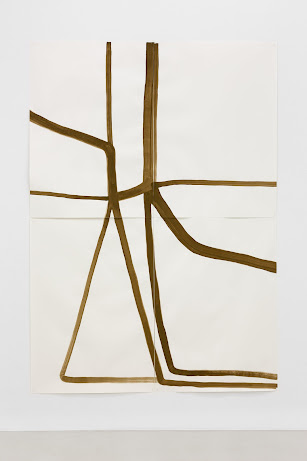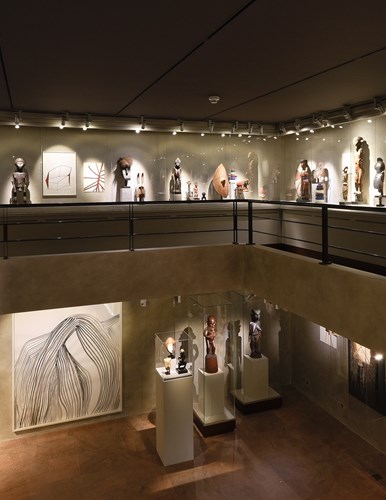Painterly Drawing
Traditional drawing is done with a pencil or pen that makes a fine line. Expanding on that, a brush can be used to make a Brush Drawing. These have a wider stroke but are not used to fill regions in the way that paintings do. Generally speaking, drawings show strokes.
Note that the Lichtenstein works recently seen have outlining, fill lines, and dots that give some of the character of a drawing.
Drawings by Two Women Artists
Silvia Bachli
Silvia Bachli is a Swiss artist who gives expressive life to brush lines. These can look like hanging ropes or even like living things.
Next, see a mesh of lines reminiscent of a chain link fence or a topography drawing. Notice the sides look cut off as if the pattern continues beyond the edge.
Silvia Bachli was invited to exhibit her work amongst the works in the Museo Barbier-Mueller in Geneva Switzerland. That is a private museum of ethnographic and art objects. Bachli's art is placed so as to complement the museum's own works. Look carefully to find her works in the museum photos.
The art cohabitation came out well by my observation. Bachli's works are bigger than you might expect for drawings. I wonder what kind of brush or device she used for such long strokes of roughly six feet. I see no sign that she stopped, reloaded the brush, then continued.
Do you find her works appropriate to the setting? Do her works enhance the others and vice versa? Can you explain your reaction?
Sedje Hemon
There are fine curved lines and broader areas somewhat like a twisting ribbon that shows its edge at times and its width at other times as it curls.
Notice the omitted parts of the hat. Our mind has no trouble with that. We are free to fill it in or not. What else do you see that adds power to the artwork?
See the painterly drawing by the Dutch artist Sedje Hemon. Notice that it looks a bit like calligraphy.
There are fine curved lines and broader areas somewhat like a twisting ribbon that shows its edge at times and its width at other times as it curls.
Can you find numbers in it? If you draw a succession of curves and make some sharp changes of direction it is not surprising that some numbers can show up inadvertently. On the other hand maybe she put them in deliberately.
Emil Nolde
To round out our discussion of brush drawing let's look at two works by the German Expressionist Emil Nolde. First, a self portrait.
Notice the omitted parts of the hat. Our mind has no trouble with that. We are free to fill it in or not. What else do you see that adds power to the artwork?
Next see a sea scape with some watercolor added. The subject is a tug boat in the Hamburg Germany harbor. Notice the pale yellow sky and touch of purple (complement of yellow) in the smoke. Note again the expressiveness and economy of means. Nolde was born near Seebul a small town on the peninsula north of Hamburg in what is now Denmark.






.jpg)


Comments
Post a Comment
You are invited to comment if you wish.